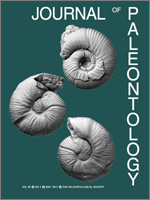The early Late Carboniferous rocks of the Guandacol Formation in western Argentina preserve the glacial to postglacial transition. In the study area, this unit has been divided in three intervals: 1) a lower diamictitic interval; 2) a middle interval chiefly composed of mudstone, and 3) an upper sandstone-dominated interval. The lower interval records infill of a fjord incised into the underlying Ordovician limestone. The middle and upper intervals reflect postglacial sedimentation. Four ichnotaxa, occurring as both discrete and compound trace fossils, are documented from the lower and middle intervals of the Guandacol Formation. Diplopodichnus biformis and Cruziana diplopoda n. isp. occur in the thinly bedded stratified diamictite in the upper section of the lower interval. These deposits record sedimentation from debris flows with dropstones reflecting overprinting of ice-rafting and rain-out processes. Cruziana cf. problematica and Rusophycus carbonarius are present in very-fine to fine-grained sandstone layers interbedded with dropstone-bearing mudstone in the lower section of the middle interval. These deposits record the interplay of suspension fall-out sedimentation, ice-rafting, rain-out processes, and storm waves. The presence of linguliformean brachiopods in coeval beds nearby strongly suggests marine influence and that brackish-water conditions prevailed during the early phase of the transgression. Harsh paleoenvironmental conditions may explain the small size of the trace fossils and the low ichnodiversity in comparison to that expected in fully marine environments. The morphology of the trace fossils as bilobate ridges and furrows ornamented with scratch marks indicates that the structures were produced by arthropods, most likely trilobites and/or notostracans. Although the possibility that different ichnotaxa have resulted from changes in burrowing behaviors can not be completely disregarded, the fact that distinct Cruziana ichnospecies display non-overlapping facies distribution may suggest their production by different arthropods.
How to translate text using browser tools
1 May 2011
Life in the Late Paleozoic Ice Age: Trace Fossils from Glacially Influenced Deposits in a Late Carboniferous Fjord of Western Argentina
Elizabeth R. Schatz,
María Gabriela Mángano,
Luis A. Buatois,
Carlos Oscar Limarino
ACCESS THE FULL ARTICLE

Journal of Paleontology
Vol. 85 • No. 3
May 2011
Vol. 85 • No. 3
May 2011
Carboniferous
glacial deposits
Gondwana
taphonomy
trace fossils




